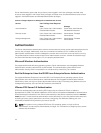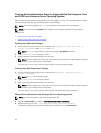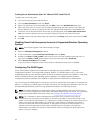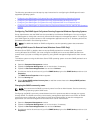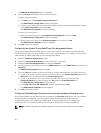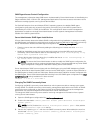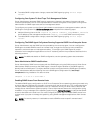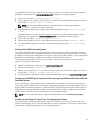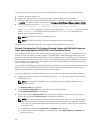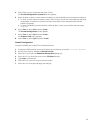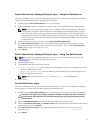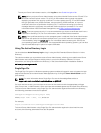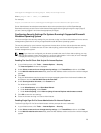
4. To enable SNMP configuration changes, restart the SNMP agent by typing: service snmpd
restart.
Configuring Your System To Send Traps To A Management Station
Server Administrator generates SNMP traps in response to changes in the status of sensors and other
monitored parameters. One or more trap destinations must be configured on the system running Server
Administrator for SNMP traps to be sent to a management station.
To configure your system running Server Administrator to send traps to a management station, edit the
SNMP agent configuration file, /etc/snmp/snmpd.conf, and perform the following steps:
1. Add the following line to the file: trapsink IP_address community_name, where IP_address is
the IP address of the management station and community_name is the SNMP community name.
2. To enable SNMP configuration changes, restart the SNMP agent by typing: service snmpd
restart.
Configuring The SNMP Agent On Systems Running Supported SUSE Linux Enterprise Server
Server Administrator uses the SNMP services provided by the net-snmp agent. You can configure the
SNMP agent to enable SNMP access from remote hosts, change the community name, enable Set
operations, and send traps to a management station. To configure your SNMP agent for proper
interaction with management applications such as IT Assistant, perform the procedures described in the
following sections.
NOTE: For additional details on SNMP configuration, see the operating system documentation.
Sever Administrator SNMP Install Actions
Server Administrator SNMP communicates with the SNMP agent using the SMUX protocol. When Server
Administrator SNMP connects to the SNMP agent, it sends an object identifier to the SNMP agent to
identify itself as a SMUX peer. This object identifier must be configured with the SNMP agent, therefore,
Server Administrator adds the following line to the SNMP agent configuration file, /etc/snmp/
snmpd.conf, during installation if it does not exist:
smuxpeer .1.3.6.1.4.1.674.10892.1
Enabling SNMP Access From Remote Hosts
The default SNMP agent configuration on SUSE Linux Enterprise Server operating systems gives read-only
access to the entire MIB tree for the public community from the local host only. This configuration does
not allow SNMP management applications such as IT Assistant running on other hosts to discover and
manage Server Administrator systems properly. If Server Administrator detects this configuration during
installation, it logs a message to the operating system log file,
/var/log/messages, to indicate that SNMP
access is restricted to the local host. You must configure the SNMP agent to enable SNMP access from
remote hosts if you plan to manage the system by using SNMP management applications from remote
hosts.
NOTE: For security reasons, it is advisable to restrict SNMP access to specific remote hosts if
possible.
22



